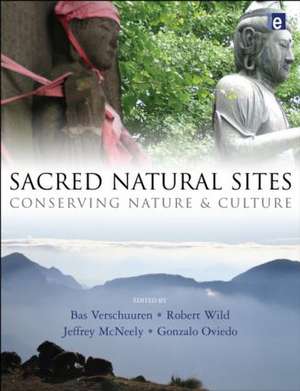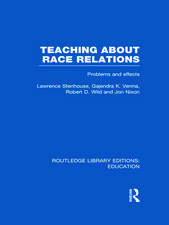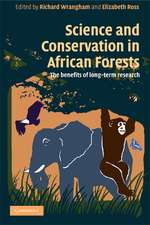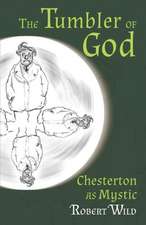Sacred Natural Sites: Conserving Nature and Culture
Editat de Bas Verschuuren, Robert Wild, Jeffrey Mcneely, Gonzalo Oviedoen Limba Engleză Paperback – 5 oct 2010
| Toate formatele și edițiile | Preț | Express |
|---|---|---|
| Paperback (1) | 433.73 lei 6-8 săpt. | |
| Taylor & Francis – 5 oct 2010 | 433.73 lei 6-8 săpt. | |
| Hardback (1) | 1022.36 lei 6-8 săpt. | |
| Taylor & Francis – 5 oct 2010 | 1022.36 lei 6-8 săpt. |
Preț: 433.73 lei
Preț vechi: 510.28 lei
-15% Nou
Puncte Express: 651
Preț estimativ în valută:
83.00€ • 86.55$ • 68.98£
83.00€ • 86.55$ • 68.98£
Carte tipărită la comandă
Livrare economică 21 martie-04 aprilie
Preluare comenzi: 021 569.72.76
Specificații
ISBN-13: 9781849711678
ISBN-10: 1849711674
Pagini: 336
Dimensiuni: 189 x 246 x 20 mm
Greutate: 0.64 kg
Ediția:1
Editura: Taylor & Francis
Colecția Routledge
Locul publicării:Oxford, United Kingdom
ISBN-10: 1849711674
Pagini: 336
Dimensiuni: 189 x 246 x 20 mm
Greutate: 0.64 kg
Ediția:1
Editura: Taylor & Francis
Colecția Routledge
Locul publicării:Oxford, United Kingdom
Public țintă
Academic and Professional Practice & DevelopmentCuprins
ForewordPreface1. Introduction: Sacred Natural Sites: the Foundations of ConservationPart I: Towards the Science and Spirituality of Sacred Natural Sites2. Conservation of Biodiversity in Sacred Natural Sites in Asia and Africa: a Review of the Scientific Literature. 3. Sacred Mountains and Global Change: Impacts and Responses4. Falling Between the 'Cracks' of Conservation and Religion: The Role of Stewardship for Sacred Trees and Groves 5. The Enchanted Earth: Numinous Sacred Sites 6. A Review of Sacred Natural Sites and Arguments for Developing Biocultural Conservation ApproachesPart II: Sacred Natural Sites: Mutual Learning, Analysis, Planning and Management7. Nature Saint and Holy Island, Ancient Values in a Modern Economy: The Enduring Influence of St. Cuthbert and Lindisfarne, United Kingdom 8. Tourism Meets the Sacred: Khumbu Sherpa Place-Based Spiritual Values in Sagarmatha (Mount Everest) National Park and Buffer Zone, Nepal. 9. The Road to the Future? The Bio-cultural Values of the Holy Hill Forests of Yunnan Province, China 10. Uncovering the Intangible Values of Earth Care: Using Cognition to Reveal the Eco-spiritual Domains and Sacred Values of the Peoples of Eastern Kham 11. Ancestral Beliefs and Conservation: The Case of Sacred Areas in Bandjoun, West Cameroon 12. The Crocodile is our Brother: Conservation Management of the Sacred Lakes of the Niger Delta, NigeriaPart III: Sacred Natural Sites: International Recognition, Global Governance and Field Action 15. Sacred Natural Sites, Cultural Landscapes and UNESCO's Action 16. Synergies and Challenges for Legal Protection of Sacred Natural Sites in the South Pacific 17. The Cultural and Spiritual Values of Wetlands and their Sacred Natural Sites in the Ramsar Convention18. Sacred Natural Sites, Biodiversity and Well-being: the Role of Sacred Sites in Endogenous Development in the Compas Network 19. Delos Initiative, Experience with Sacred Natural Sites in Technologically Developed Countries 20. Developing and Testing a Methodology and Tools for the Inventory of Sacred Natural Sites of Indigenous and Traditional Peoples in Mexico21. Culture-based Conservation and Recovery of Sacred Groves: Experiences from the North Western Ghats, Maharastra, India Part IV: In our Own Hands: Living Culture and Equity at Sacred Natural Sites22. Community-Based Ecotourism at Tafi Atome Sacred Monkey Sanctuary in Ghana 23. Sacred Valley, Conservation Management and Indigenous Survival: Uch Enmek Indigenous Nature Park, Altai Republic, Russia 24. Towards a Sustainable Management and Enhanced Protection of Sacred Marine Areas at Palawan's Coron Island Ancestral Domain, Philippines 25. Culture, Conservation and Co-management: Mapping Soliga Stake in Biodiversity Conservation in Biligiri Rangaswamy Temple Wildlife Sanctuary, India 26. Devi as Ecofeminist Warrior: Reclaiming the Role of Sacred Natural Sites in East-Central India 27. Conclusion: Using Sacred Natural Sites to Conserve Nature and Culture
Notă biografică
Bas Verschuuren serves as Co-chair with IUCN's Specialist Group on Cultural and Spiritual Values of Protected Areas, and is a scientist and facilitator with EarthCollective. Bas has over 10 years of international experience integrating cultural and spiritual values in conservation management and policy.
Robert G. Wild is an ecologist and social scientist with 25 years practical experience of working with communities at protected areas in East Africa, Caribbean, Indian Ocean and Europe. He is chair of the IUCN's Specialist Group on Cultural and Spiritual Values of Protected Areas.
Jeffrey A. McNeely is Senior Science Advisor at the International Union for Conservation of Nature. He has worked in international conservation for over forty years and has written or edited dozens of books on a wide range of topics that include cultural values of nature.
Gonzalo Oviedo is an anthropologist and environmentalist and works as Senior Adviser for Social Policy at the International Union for Conservation of Nature facilitating the integration of social issues in conservation work worldwide. Gonzalo focuses on livelihood security, culture, rights and governance.
Robert G. Wild is an ecologist and social scientist with 25 years practical experience of working with communities at protected areas in East Africa, Caribbean, Indian Ocean and Europe. He is chair of the IUCN's Specialist Group on Cultural and Spiritual Values of Protected Areas.
Jeffrey A. McNeely is Senior Science Advisor at the International Union for Conservation of Nature. He has worked in international conservation for over forty years and has written or edited dozens of books on a wide range of topics that include cultural values of nature.
Gonzalo Oviedo is an anthropologist and environmentalist and works as Senior Adviser for Social Policy at the International Union for Conservation of Nature facilitating the integration of social issues in conservation work worldwide. Gonzalo focuses on livelihood security, culture, rights and governance.
Recenzii
"This book is being published in the International Year of Biodiversity, which gives it special importance as an expression of the special relationship between people and the rest of nature. It offers us an opportunity to remind ourselves of the deep and meaningful relationships that many religions and faith communities have with nature, demonstrated by their devotion to sacred natural sites such as those described in these pages." – Julia Marton-Lefèvre, Director General, International Union for Conservation of Nature, Gland, Switzerland
'If science is to serve life on this planet, we need more than just intellectual rigour, we also need ethical vigour. That demands values. But what might inform these? One basis is that which human experience has termed 'the sacred'. For some, 'the sacred' is a hypothetical concept. For others, it is a function of empirical experience in consciousness. Either way, this milestone of a book shows that the impact on nature conservation can be hugely positive, inviting scholarly critique and appreciation.' – Professor Alastair McIntosh, Centre for Human Ecology, University of Strathclyde, UK and author of Soil and Soul
"Sacred Natural Sites sports an international all-star cast and concise, no-nonsense chapters. The study of sacred natural areas has come of age, and this is the book to prove it." – Fikret Berkes, Distinguished Professor and Canada Research Chair at the University of Manitoba, and the author of Sacred Ecology
"This excellent book is a welcome addition to the academic and professional literature in the relationship between people and nature. The book is a must for all managers of heritage places where sacred natural sites occur, academics, heritage professionals, and students, not just of sacred natural sites but for those also from the culture side. It also ought to be brought to the attention of those preparing World Heritage nominations and to government agencies where the less famous examples exist outside formally protected areas and heritage sites." – Ken Taylor, IJHS Australia.
"...the volume works very well in providing appropriately-edited ‘signposts’ of issues and actions relevant to the intersection of nature and culture from across the globe, enabling practitioners to situate their own work in a wider context. It also meets the editors’ aims to provide a basis for future practical advocacy and action, raising both the profile of sacred natural sites as well as underlining the broader need to consider natural and cultural values in conservation activity." – Marcus Barber, Australasian Journal of Environmental Management
"Is scientific knowledge in conflict with religious sentiment? This book answers the question through the various case studies cited from Africa, the Indian subcontinent, South America, Russia, China and the United Kingdom, [and] shows that knowledge enhances understanding, and deepens sentiment regarding nature." – Manjusha Misra, School of Planning and Architecture, Bhopal, International Journal of Environmental Studies.
"This excellent book is a welcome addition to the academic and professional literature in the relationship between people and nature. The book is a must for all managers of heritage places where sacred natural sites occur, academics, heritage professionals, and students, not just of sacred natural sites but for those also from the culture side. It also ought to be brought to the attention of those preparing World Heritage nominations and to government agencies where the less famous examples exist outside formally protected areas and heritage sites." – Ken Taylor, IJHS Australia.
"It is an interesting book to have on your shelf, providing an excellent reference text for students, academics, and other individuals interested in natural sacred places. I would hope that it might also appear on the desks of legislators—or that it might at least be summarized by their staff in their briefs, to highlight the importance and vulnerability of these amazing places." - Kathy Velander, Mountain Research and Development
"In introducing the reader to the diverse world of sacred natural sites and exploring their potential for conservation planning and management, this is a publication that should be on the bookshelf of any scholar working on conservation related issues, irrespective of their disciplinary grounding." - James P. Robson, Human Ecology
"The book is a must for all managers of heritage places where sacred natural sites occur, academics, heritage professionals, and students, not just of sacred natural sites but for those also from the culture side. It also ought to be brought to the attention of those preparing World Heritage nominations and to government agencies where the less famous examples exist outside formally protected areas and heritage sites." - Emeritus Professor Ken Taylor, National Environmental Law Review
'If science is to serve life on this planet, we need more than just intellectual rigour, we also need ethical vigour. That demands values. But what might inform these? One basis is that which human experience has termed 'the sacred'. For some, 'the sacred' is a hypothetical concept. For others, it is a function of empirical experience in consciousness. Either way, this milestone of a book shows that the impact on nature conservation can be hugely positive, inviting scholarly critique and appreciation.' – Professor Alastair McIntosh, Centre for Human Ecology, University of Strathclyde, UK and author of Soil and Soul
"Sacred Natural Sites sports an international all-star cast and concise, no-nonsense chapters. The study of sacred natural areas has come of age, and this is the book to prove it." – Fikret Berkes, Distinguished Professor and Canada Research Chair at the University of Manitoba, and the author of Sacred Ecology
"This excellent book is a welcome addition to the academic and professional literature in the relationship between people and nature. The book is a must for all managers of heritage places where sacred natural sites occur, academics, heritage professionals, and students, not just of sacred natural sites but for those also from the culture side. It also ought to be brought to the attention of those preparing World Heritage nominations and to government agencies where the less famous examples exist outside formally protected areas and heritage sites." – Ken Taylor, IJHS Australia.
"...the volume works very well in providing appropriately-edited ‘signposts’ of issues and actions relevant to the intersection of nature and culture from across the globe, enabling practitioners to situate their own work in a wider context. It also meets the editors’ aims to provide a basis for future practical advocacy and action, raising both the profile of sacred natural sites as well as underlining the broader need to consider natural and cultural values in conservation activity." – Marcus Barber, Australasian Journal of Environmental Management
"Is scientific knowledge in conflict with religious sentiment? This book answers the question through the various case studies cited from Africa, the Indian subcontinent, South America, Russia, China and the United Kingdom, [and] shows that knowledge enhances understanding, and deepens sentiment regarding nature." – Manjusha Misra, School of Planning and Architecture, Bhopal, International Journal of Environmental Studies.
"This excellent book is a welcome addition to the academic and professional literature in the relationship between people and nature. The book is a must for all managers of heritage places where sacred natural sites occur, academics, heritage professionals, and students, not just of sacred natural sites but for those also from the culture side. It also ought to be brought to the attention of those preparing World Heritage nominations and to government agencies where the less famous examples exist outside formally protected areas and heritage sites." – Ken Taylor, IJHS Australia.
"It is an interesting book to have on your shelf, providing an excellent reference text for students, academics, and other individuals interested in natural sacred places. I would hope that it might also appear on the desks of legislators—or that it might at least be summarized by their staff in their briefs, to highlight the importance and vulnerability of these amazing places." - Kathy Velander, Mountain Research and Development
"In introducing the reader to the diverse world of sacred natural sites and exploring their potential for conservation planning and management, this is a publication that should be on the bookshelf of any scholar working on conservation related issues, irrespective of their disciplinary grounding." - James P. Robson, Human Ecology
"The book is a must for all managers of heritage places where sacred natural sites occur, academics, heritage professionals, and students, not just of sacred natural sites but for those also from the culture side. It also ought to be brought to the attention of those preparing World Heritage nominations and to government agencies where the less famous examples exist outside formally protected areas and heritage sites." - Emeritus Professor Ken Taylor, National Environmental Law Review

















